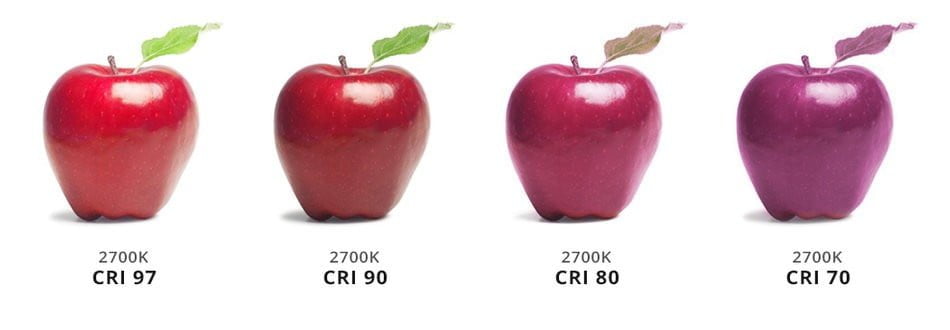Colour rendering index (CRI)
High quality LED lights also have a high colour rendering index, or CRI. A good colour rendering index (CRI) for domestic use is over 90, and today many luminaires are close to 100. The CRI tells us how well an LED lamp displays colours as they should be. The ultimate breakthrough of LED lighting has been hampered by its poor ability to produce the colours of the illuminated object naturally, according to critics. This manifests itself as a bluish light or a grey haze. The most difficult thing for an LED circuit to produce is red (R=9).
The colour rendering index is expressed as a number on a scale from zero to 100, where 0 = no colour reproduction and 100 = full colour reproduction. Sometimes the scale is also seen in the negative direction, where light can even reduce a particular hue in the environment. For LED luminaires, the colour rendering index is also given as the so-called. Ra values, which are often measured on a smaller scale than CRI. This Ra figure does not include, for example, shades of red, or skin tones, in which case the value is called the Ra value. an embellished figure for the actual quality of the LED.
The colour rendering index does not indicate the colour of light, but how well the light reproduces the colours of other objects. The colour temperature of light, on the other hand, indicates the colour of the white light produced by light. The colour temperature is expressed in Kelvin. A traditional incandescent bulb is typically 2 700K (yellowish), an office light 4 000K (white), outdoors in Finland around 5 500K (bluish). Today, the most popular light tones in interior design are 3 000K (warm white) and 4 000K (neutral white).
In earlier light sources, the colour rendering index did not play such an important role, as light sources such as incandescent lamps always had a high level of colour rendering index. LED technology has brought energy savings and other benefits, but attention must be paid to the colour rendering index.
The price of high CRI LED luminaires?
LED lights that match the colour rendering of the full spectrum are very expensive. Or are they? You can access the online shop here.
Good colour reproduction means a lot. It’s nice to see the right shades when putting on make-up or cooking, or to know what colour clothes or furniture really are. In addition, in low light, the mind becomes apathetic and something feels wrong even when the lights are on.
Light with a colour rendering index above 85 is generally perceived as quite natural. Light below CRI 80 is perceived as unnatural or coloured, or certain objects appear strange in the light. The weakness of low-cost LED luminaires is still their poor colour rendering (CRI 60-80). So check what you’re buying if the quality of light matters to you. Especially when it comes to buying LED luminaires, which at best last around 50,000 hours, or around 15 years depending on hours of use, without bulb replacement.
In our view, lighting either spoils or enhances the beauty of a home. Lighting is one of the most visible parts of our homes, because it sets the mood for everything else in the interior.
Typical requirements for CRI:
Light or video photography over 90
Domestic use over 85
Office over 80
Industry over 70
The CRI of LedStore luminaires is up to 98!
To this end, LedStore offers new innovations and LED lighting, where features previously only seen in the most expensive products are now available to all. LedStore offers good colour rendering LED lamps for everyone, luxury for every home! LedStore products are manufactured by our own contract manufacturers, and we develop them together with world-class factories.
LED panel CRI 95
LED bulbs CRI 95-97
LED spots CRI 98, we give a 7 year warranty on our spots.

